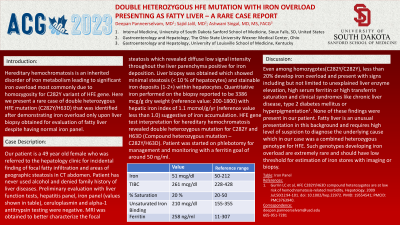Tuesday Poster Session
Category: Liver
P3969 - Double Heterozygous HFE Mutation With Iron Overload Presenting as Fatty Liver – A Rare Case Report
Tuesday, October 24, 2023
10:30 AM - 4:00 PM PT
Location: Exhibit Hall

Has Audio

Deepan Panneerselvam, MD
University of South Dakota Sanford School of Medicine
Sioux Falls, SD
Presenting Author(s)
Deepan Panneerselvam, MD1, Sajid Jalil, MD2, Ashwani K. Singal, MD, MS, FACG3
1University of South Dakota Sanford School of Medicine, Sioux Falls, SD; 2The Ohio State Wexner Medical Center, Columbus, OH; 3University of South Dakota, Sioux Falls, SD
Introduction: Hereditary hemochromatosis is an inherited disorder of iron metabolism leading to significant iron overload most commonly due to homozygosity for C282Y variant of HFE gene. Here we present a rare case of double heterozygous HFE mutation (C282Y/H63D) that was identified after demonstrating iron overload only upon liver biopsy obtained for evaluation of fatty liver despite having normal iron panel.
Case Description/Methods: Our patient is a 49 year old female who was referred to the hepatology clinic for incidental finding of focal fatty infiltration and areas of geographic steatosis in CT abdomen. Patient has never used alcohol and denied family history of liver diseases. Preliminary evaluation with liver function tests, hepatitis panel, iron panel (values shown in table), ceruloplasmin and alpha-1 antitrypsin testing were negative. MRI was obtained to better characterize the focal steatosis which revealed diffuse low signal intensity throughout the liver parenchyma positive for iron deposition. Liver biopsy was obtained which showed minimal steatosis (< 10 % of hepatocytes) and stainable iron deposits (1-2+) within hepatocytes. Quantitative iron performed on the biopsy reported to be 3386 mcg/g dry weight (reference value: 200-1800) with hepatic iron index of 1.1 mcmol/g/yr (reference value less than 1.0) suggestive of iron accumulation. HFE gene test interpretation for hereditary hemochromatosis revealed double heterozygous mutation for C282Y and H63D (Compound heterozygous mutation – C282Y/H63D). Patient was started on phlebotomy for management and monitoring with a ferritin goal of around 50 ng/ml.
Discussion: Even among homozygotes(C282Y/C282Y), less than 20% develop iron overload and present with signs including but not limited to unexplained liver enzyme elevation, high serum ferritin or high transferrin saturation and clinical syndromes like chronic liver disease, type 2 diabetes mellitus or hyperpigmentation. None of these findings were present in our patient. Fatty liver is an unusual presentation in this background and requires high level of suspicion to diagnose the underlying cause which in our case was a combined heterozygous genotype for HFE. Such genotypes developing iron overload are extremely rare and should have low threshold for estimation of iron stores with imaging or biopsy.
Disclosures:
Deepan Panneerselvam, MD1, Sajid Jalil, MD2, Ashwani K. Singal, MD, MS, FACG3. P3969 - Double Heterozygous HFE Mutation With Iron Overload Presenting as Fatty Liver – A Rare Case Report, ACG 2023 Annual Scientific Meeting Abstracts. Vancouver, BC, Canada: American College of Gastroenterology.
1University of South Dakota Sanford School of Medicine, Sioux Falls, SD; 2The Ohio State Wexner Medical Center, Columbus, OH; 3University of South Dakota, Sioux Falls, SD
Introduction: Hereditary hemochromatosis is an inherited disorder of iron metabolism leading to significant iron overload most commonly due to homozygosity for C282Y variant of HFE gene. Here we present a rare case of double heterozygous HFE mutation (C282Y/H63D) that was identified after demonstrating iron overload only upon liver biopsy obtained for evaluation of fatty liver despite having normal iron panel.
Case Description/Methods: Our patient is a 49 year old female who was referred to the hepatology clinic for incidental finding of focal fatty infiltration and areas of geographic steatosis in CT abdomen. Patient has never used alcohol and denied family history of liver diseases. Preliminary evaluation with liver function tests, hepatitis panel, iron panel (values shown in table), ceruloplasmin and alpha-1 antitrypsin testing were negative. MRI was obtained to better characterize the focal steatosis which revealed diffuse low signal intensity throughout the liver parenchyma positive for iron deposition. Liver biopsy was obtained which showed minimal steatosis (< 10 % of hepatocytes) and stainable iron deposits (1-2+) within hepatocytes. Quantitative iron performed on the biopsy reported to be 3386 mcg/g dry weight (reference value: 200-1800) with hepatic iron index of 1.1 mcmol/g/yr (reference value less than 1.0) suggestive of iron accumulation. HFE gene test interpretation for hereditary hemochromatosis revealed double heterozygous mutation for C282Y and H63D (Compound heterozygous mutation – C282Y/H63D). Patient was started on phlebotomy for management and monitoring with a ferritin goal of around 50 ng/ml.
Discussion: Even among homozygotes(C282Y/C282Y), less than 20% develop iron overload and present with signs including but not limited to unexplained liver enzyme elevation, high serum ferritin or high transferrin saturation and clinical syndromes like chronic liver disease, type 2 diabetes mellitus or hyperpigmentation. None of these findings were present in our patient. Fatty liver is an unusual presentation in this background and requires high level of suspicion to diagnose the underlying cause which in our case was a combined heterozygous genotype for HFE. Such genotypes developing iron overload are extremely rare and should have low threshold for estimation of iron stores with imaging or biopsy.
Disclosures:
Deepan Panneerselvam indicated no relevant financial relationships.
Sajid Jalil indicated no relevant financial relationships.
Ashwani K. Singal indicated no relevant financial relationships.
Deepan Panneerselvam, MD1, Sajid Jalil, MD2, Ashwani K. Singal, MD, MS, FACG3. P3969 - Double Heterozygous HFE Mutation With Iron Overload Presenting as Fatty Liver – A Rare Case Report, ACG 2023 Annual Scientific Meeting Abstracts. Vancouver, BC, Canada: American College of Gastroenterology.
